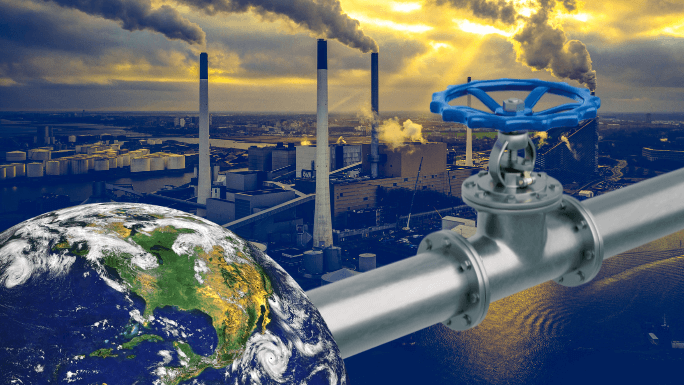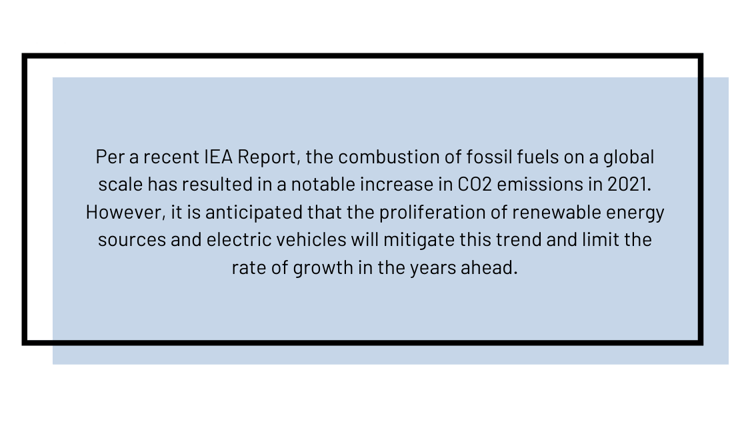
Industrial Sealing Techniques: Mitigating Fugitive Emissions
Posted by CDI Products on May 24, 2023
Fugitive emissions are a significant concern to industries worldwide looking to be good stewards of the environment. As per the International Energy Agency's report[i], a considerable proportion of the global methane emissions are categorized as fugitive emissions, amounting to 20% of the annual 570 million metric tons. Due to increased concerns about health, safety, and environmental protection, fugitive emissions have become a major focus for industrial equipment end users, oil and natural gas operators, midstream and pipeline companies, chemical plants, refineries, and other industrial facilities. Let us first examine the definition of fugitive emissions and evaluate the potential factors that may cause your system to encounter issues related to fugitive emissions.
What are fugitive emissions?
Fugitive emissions are the inadvertent and unwanted emission, evaporation, flare, spill, leakage, or discharge of gases or vapors from pressure-containing equipment or facilities. The aforementioned encompasses any damages incurred due to internal components within a plant, refinery, or another industrial complex, including valves, pipe flanges, storage tanks, and pressurized rotating equipment, such as pumps and compressors. These fugitive gases and vapors include volatile organic compounds (VOCs) and greenhouse gases such as carbon dioxide, methane, perfluorocarbons, sulfur hexafluoride, and nitrogen trifluoride.
Fugitive emissions can be regarded as a gradual and cumulative environmental harm which at the individual level might not seem significant, but counted together across the globe, can have a major impact to the ecology. Fugitive emissions can be likened to the undesirable effects of inadequate insulation on a home which cannot stay cool in the summer or warm in the winter. Instead of emitting hot or cold air, the discharge consists of harmful gases.

To safeguard the environment and promote health and safety, industrial and governmental entities have implemented stricter regulations on fugitive emissions. These regulations have posed more arduous obstacles for Leak Detection and Repair (LDAR) initiatives. Fugitive emissions are regulated by various national and international organizations, including the U.S. Environmental Protection Agency (EPA), the European Union (EU), the American Petroleum Institute (API), and the International Organization for Standardization (ISO). The emissions of VOCs are a matter of considerable environmental apprehension due to their potential for inducing Photochemical Ozone Creation Potential (POCP), Ozone Depletion Potential (ODP), Global Warming Potential (GWP), toxicity, carcinogenicity, and local nuisance from odor. The mitigation of volatile organic compound (VOC) emissions is a critical concern for numerous industrial operations.
Why do fugitive emissions occur?
Fugitive emissions stemming from equipment leaks are inadvertent losses that may arise due to inadequate seal design, routine wear and tear, defective or incomplete component assembly, inadequate material specification, manufacturing defects, damage incurred during installation or usage, corrosion, fouling, and environmental factors. The average emissions of components are observed to increase when exposed to frequent thermal cycling, vibrations, or cryogenic service.
Fugitive emissions pose a significant risk due to the difficulty in detecting their presence using conventional control systems and facility monitoring equipment, which can result in uncontrolled atmospheric leaks. Apart from the plausible environmental implications, fugitive emissions can also give rise to a substantial economic liability due to the significant loss of potentially valuable resources and the consequent reduction in equipment and/or production efficiency. In the majority of cases, the genuine expenses are not fully recognized due to the fact that numerous costs linked with fugitive emissions remain imperceptible. The concept of invisible costs encompasses various expenses that are not immediately apparent but are associated with the repair of leaks, such as labor costs, materials costs, energy wastage, plant inefficiencies, expenses related to environmental remediation, penalties for environmental violations, diminished sales due to negative public perception, and compensation claims for personal injuries. The true value associated with fugitive emissions is contingent upon multiple factors including:
- Rates of Production
- Equipment design
- Age and quality of the equipment
- Standard of installation
- Vapor pressure of the process fluid
- Process temperature and pressure
- Number and type of sources
- Inspection and maintenance routine
How can seals prevent fugitive emissions?
Seals are integral components in industrial applications like chemical plants and petroleum refineries, serving the purpose of mitigating leaks and confining pressure within valves, pumps and other rotating apparatus. A new generation of mechanical seal devices has been created in recent years to offer value-focused solutions for the management of fugitive emissions in pumps. Across the equipment spectrum, sealing technology has been continuously upgraded in preparation of growing environmental restrictions. The service life of a seal may be influenced by various external factors such as appropriate material selection for construction, effective implementation of the design methodology, utilization of advanced manufacturing processes, consideration of potential adversities that the seal may encounter, and contemplation of the impact of the process medium on the seal. Through appropriate seal and material selection and effective maintenance practices, organizations can mitigate the potential for fugitive emissions and ensure adherence to regulatory standards. Four important factors can impact the quality of the sealing conditions.
- Material Selection - The appropriate selection of sealing materials for a given application is essential to mitigate fugitive emissions. Seals can be fabricated using diverse materials – such as rubber, plastic, flexible graphite, or combinations of each- with each material exhibiting distinct characteristics, benefits, and constraints. The selection of appropriate material for a given application can significantly contribute to the efficacy and durability of the seal and greatly affect the emissions seen over the life of the seal.
- Proper Installation - The correct installation of seals is of utmost importance in mitigating fugitive emissions. The proper installation of seals, with appropriate tension, is crucial for the establishment of an efficient seal. Incorrect installation can cause damage which, while might not be instantly apparent, can contribute to an undesired increase in emissions over time.
- Routine inspection - It is imperative to conduct routine inspections on seals in order to detect any indications of deterioration or impairment, and subsequently substitute them as required.
- Proper Maintenance - It is recommended that companies establish a maintenance program that encompasses routine inspection and replacement of seals to guarantee their optimal functionality. Having a robust and proactive leak detection program can ensure seals are replaced or adjusted proactively, preventing unwanted emissions. Through this approach, corporations can mitigate the likelihood of fugitive emissions and guarantee the safety and regulatory adherence of their operations.
What types of sealing devices can help prevent fugitive emissions?
- Mechanical Seals – Mechanical Seals are utilized to seal rotating shafts entering the housing of pumps, centrifugal compressors, and agitators. The seals prevent gases and liquids from escaping the space where the shaft and housing are in relative motion. Diverse mechanical seal technologies are utilized, including single spring seals, double seals, dry gas seals, and moist oil seals, all of which have substantially distinct emission characteristics. There are many kinds of secondary containment devices, including fixed or floating bushing and lip seals (spring energized or pressure energized) which also help prevent leaks and uncontrolled emissions. Polymer and elastomeric seals are custom-molded or machined components made from various materials whose characteristics are ideal for sealing liquids and gases in pressure-containing systems. Seals and rings can also be manufactured using flexible graphite which can handle even more extreme temperatures and environmental conditions depending on the fluids or gases flowing in the system.
- Piston Rings - Piston rings fill the gap between the piston and the cylinder liner. The material is primarily non-metallic, providing a unique mix of sealing and bearing qualities. They meet the operational requirements of many reciprocating compressors in oil-free use as well as applications that allow for varying amounts of lubrication. Piston rings can come in various orientations including one-piece, multi-piece, or segmental rings.
- Compression Packing - Compression packing is often constructed of braided fibers and is used to seal the valve stems and shafts of reciprocating compressors. Valves have been found as a key source to emissions, owing to their extraordinarily high utilization. Modern fibers and building technologies enable sealing at extremely low emission levels.
- Gaskets - Gaskets create a static seal between two stationary components. Gaskets are used on flanges that link pipelines, valves, compressors, pumps, instruments, and many other types of equipment, such as heat exchangers. Because of the substantial number of flanges and equipment connections sensitive to the thermal and mechanical stresses associated with industrial processes, the proper use of high-performance gaskets can considerably contribute to lower fugitive emission levels. Soft cut gaskets, semi metallic gaskets, and metallic gaskets are the three types of gaskets. The right gasket is critical, and is should be chosen based on chemical compatibility, service temperature, and pressure.
- Stem Packing – Various types of packing exists for valves and pumps which carry differing degrees of benefits when fugitive emissions are concerned. Compression packings made from graphite, fluoropolymers, or other materials use mechanical loading to generate positive sealing, limiting emissions. These packings are compressed and often loaded with springs to ensure a continued sealing stress is applied to the seals. An added benefit is that they can be easily adjusted in the field to increase sealing. The right design and combination of components is essential for ensuring that gasses are captured and not passed to the surrounding environment. Additionally, seals machined from fluoropolymers and other elastomers and plastics can be a preferred solution for emissions sealing when in the optimal temperature range for these materials. These seals offer the additional benefit of not requiring external loads and lower friction but have temperature limitations and cannot readily be adjusted to increase sealing when leaks are detected.
Note: You can learn more about the three major reasons seals fail here.
Regular maintenance of process plants and equipment is a crucial aspect of effective operation, encompassing both pro-active (preventative) and reactive methodologies. To mitigate fugitive emissions, proper maintenance and equipment monitoring beyond the standard control systems are essential. Although many companies rely on scheduled maintenance or focus maintenance-as-needed processes, Total Productive Maintenance (or TPM) can have a significant positive impact on your business, your environmental impact, and your bottom line. You can learn more about Total Productive Maintenance here.
In light of the global effort to mitigate adverse environmental effects and adopt the energy transition initiative, corporations can exhibit their dedication as a collaborative stakeholder by minimizing fugitive emissions stemming from their activities. The reduction of fugitive emissions not only has positive environmental implications, but it also has the potential to generate cost savings and enhance workplace safety for employees in a number of industries across the globe. Forward-thinking organizations can take proactive and transparent measures to address the issues and reduce fugitive emissions. This approach can yield tangible outcomes for both the environment and business. The responsibility of mitigating fugitive emissions falls on businesses, which encounter various challenges such as increasing regulations, outdated technology, and the necessity for a customized solution in order to maintain competitiveness in an environmentally conscious economy.
[i] https://www.iea.org/reports/world-energy-outlook-2022
Topic: stem packing, compression packing, piston ring, industrial equipment, fugitive emissions, mechanical seals, gaskets, LDAR, sealing devices
